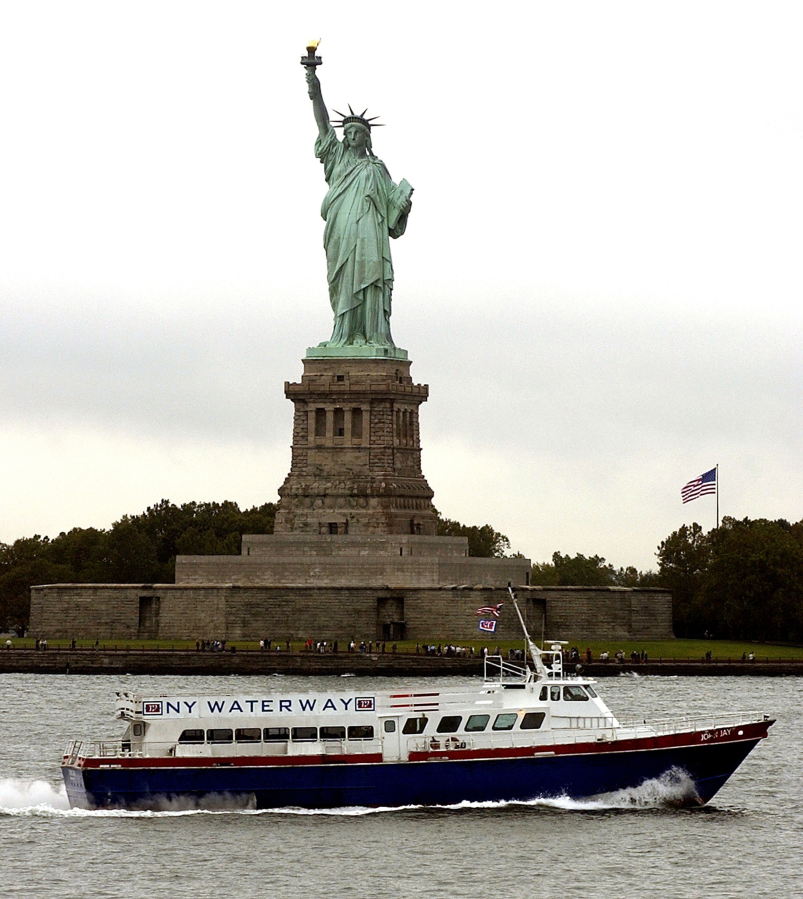STATUE OF LIBERTY NATIONAL MONUMENT, N.Y. — Her brow is resolute, as if hardened by innumerable Yankee losses. Her right arm is aloft, as if waving for the Uber guy. And her feet — they’re a ladies’ Size 879, rangers like to say.
Even if you’re hazy about who is allowed to go where inside the Statue of Liberty, you know this landmark well. I certainly thought I did.
Before my New York trip in May, I was confident that the French government gave her to the U.S. out of respect for our democracy and immigrant beginnings. I was pretty sure that the sculptor always had New York in mind. And I knew nothing about Miss Liberty’s injuries in World War I.
So there was plenty for me to learn from the rangers, the exhibits and Elizabeth Mitchell’s 2014 book, “Liberty’s Torch.” Basically, I’d been half-wrong about how she was built, how she has lasted and what she stands for.
Fortunately, getting to Liberty Island is easy. Ferries leave Battery Park, at the southern tip of Manhattan, every 15 to 20 minutes from 8:30 a.m. to 5 p.m. daily. While you line up for the airport-style security check, you can eavesdrop on fellow tourists from all over. About 4.3 million people made the trip last year.
On the 12 acres of Liberty Island (formerly Bedloe’s Island), you can roam the museum inside the statue’s pedestal, ride an elevator (or climb 192 steps) to an observation balcony at the top of the pedestal; or stay below and graze at a cafe and browse in the gift shop.
Reaching the crown is a taller order. You must make a reservation months in advance and climb 162 spiral steps (no elevator) from the top of the pedestal. Only 400 visitors per day get to do that.
And never mind the torch. It’s been off-limits since 1916. But before we get to that, here’s what I had wrong about how she was built and why.
In 1865 French intellectual Edouard de Laboulaye started promoting a big gift to the U.S. He wanted to honor the coming U.S. centennial, but also was eager to celebrate the abolitionists’ victory in the just-concluded American Civil War and throw some shade on the repressive practices of France’s ruler, Napoleon III.
Immigration? Not on Laboulaye’s agenda.
Laboulaye raised money through private donors and a lottery and commissioned a young sculptor named Auguste Bartholdi.
Today, as you approach the statue, you see how hard it must have been to build.
To begin with, it had to be made in 300-plus pieces so that it could be dismantled, shipped, then rebuilt on Bedloe’s Island, an Army base previously known for public executions.
The statue would have to withstand New York Harbor. To be visible from a distance, Lady Liberty would need to be tall — about 151 feet from toe to torch, twice that if you count her pedestal.
When the American centennial rolled around in 1876, Bartholdi had completed Liberty’s right hand and torch, but not much else.
Still, booster committees kept at it. Soon Liberty’s hand and torch were on display at the world’s fair in Philadelphia, then at Madison Square Park in New York. The head and shoulders, once Bartholdi had completed them, went to the 1878 World’s Fair in Paris. Poet Emma Lazarus pitched in by penning “The New Colossus,” about “your tired, your poor, your huddled masses yearning to breathe free” — but it had little or no short-term effect.
So if poetry and previews didn’t raise the needed money, what did?
Vanity. In 1885 newspaper mogul Joseph Pulitzer joined the fundraising and promised to print donors’ names on the front pages of his New York World and St. Louis Post-Dispatch. More than $100,000 flooded in.
By 1886 the statue was ready. On Oct. 28 of that year, a grand flotilla filled New York Harbor as President Grover Cleveland and Bartholdi unveiled Miss Liberty.
The cost of Liberty, you could say, is eternal maintenance. The National Park Service estimates that it spends $6 million a year maintaining Liberty and Ellis islands. But some years are worse than others.
Take 1916. The U.S. hadn’t officially entered World War I, but it was supplying the British with ammunition, shipping much of it from New Jersey’s Black Tom Island, less than a mile from Liberty. So the Germans hatched a plan. In the wee hours of July 30, 1916, German-backed saboteurs sneaked onto Black Tom and set off a massive series of explosions.
Seven people were killed. Though she wasn’t the target, Miss Liberty suffered more than $100,000 in damage and the torch was closed — a ban that’s never been lifted.



